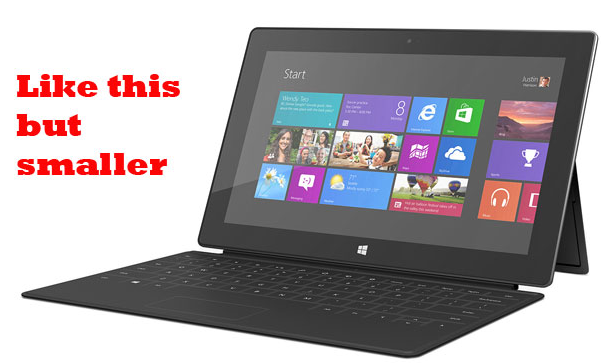Meeting in the middle: How Microsoft will enable mini Surfaces and maxi Win Phones

With Windows Blue and a coming Windows Phone 8 update, Microsoft will give legs to its plan to enable OEMs -- including Microsoft itself -- to support a burgeoning category of tweener devices, including min tablets and big-screen smartphones.

Just a year ago, Microsoft execs were pooh-poohing the advantage of smaller screen sizes for Windows devices, claiming smaller screens wouldn't allow users to handle adequately both creation and consumption tasks. But in the face of robust demand for mini tablets from its competitors, Microsoft execs changed their tune. Now the message is that Windows 8 was designed from the outset to run on smaller and bigger screens at different resolutions, primarily thanks to its new app model.
While Microsoft's new positioning is in place, at the moment, Windows Phone and Windows PC/tablet makers don't have great options in the mid-range. Microsoft really doesn't have Windows variants that are optimized for for devices with screen sizes between four and eight inches.
With Windows Phone 7, Microsoft didn't allow handset makers to put the Windows Phone OS 7 on devices with screens above 4 inches or so. That's one reason PC makers never debuted Windows Phone OS-powered tablets and had to license "full" Windows for these kinds of devices, instead.
With Windows Phone 8, Microsoft moved to a screen-resolution limit to control which Windows variant OEMs could install. Currently, the Windows Phone 8 operating system supports a maximum resolution of 720p. Putting the OS on larger screens would make the tiled UI look worse, some have argued.
But, as the Verge noted earlier this week, it looks like Microsoft is poised to change this, and will be adding support for 1080p with an update to the Windows Phone 8 operating system later this year.
One of my contacts confirmed that, as the Verge reported, the so-called "GDR3" (General Distribution Release 3) Windows Phone 8 update is where Microsoft will make this change. My contact said GDR3 will add support for five- to six-inch devices with 1080p support. Along with the higher resolution, GDR3 also could include changes in the start screen and core Windows Phone 8 apps, such as possibly adding a third column of mid-size-tiled apps in the start screen, my source added.
GDR3 is expected to be the last Windows Phone 8 OS update Microsoft releases before it introduces Windows Phone Blue. Windows Phone Blue is expected to arrive a number of months after Windows Blue, a k a Windows 8.1, possibly as late as early 2014.
It's not just a case of Windows Phone OS specs going up, however. Windows specs are coming down, too.
Windows RT doesn't really scale well below eight inches, one of my contacts told me, because the buttons and the user interface get too small. Additionally, it's not well designed for portrait mode, which is how most mini tablets tend to be used. But with Windows RT 8.1 ( Windows RT Blue), there supposedly will be improved support for portrait mode and higher-pixel-density devices, which is what would make smaller screened devices -- such as a 7-inch or 8-inch Surface, for example -- truly usable.
(Related aside: I'm going to be very curious to see if rumored 7-inch or 8-inch Surfaces are the same as the rumored "Xbox Surface." I wouldn't be surprised)
All of this maneuvering is going to enable Windows and Windows Phone makers to field everything from Windows Phones with up to six-inch screens, to Windows tablets with seven-inch screens. It supposedly doesn't open the door for OEMs making phoneless Windows Phone devices or Windows RT devices with phone support built in. But maybe one day....